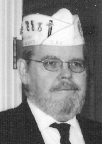 | Frank Bergquist graduated from Eddyville, IA, high school in 1958. After graduation, he entered the Army, serving 20 years in Missouri, Maryland, New Mexico, Germany, Iowa, Turkey, Kansas, S.E. Asia, and finally retiring in 1978 in Louisiana. Before retiring, Frank was assigned as an ROTC instructor at WSU and Kemper Military School until 1974. In 1978 he served as the Non-Commissioned officer in charge of operations at Fort Polk, LA. He has served as the Veterans Counselor (DVOP) with the Kansas Job Service Center National Service Office, with the Disabled American Veterans at the VA Regional Office in Wichita; Veterans Employment and Training Coordinator with the US Dept. of Labor at Ft. Riley, KS; Service Coordinator with Cerebral Palsy Research Foundation; Dept Adjutant-Treasurer and the Dept. Executive Director Dept. of Kansas Disabled American Veterans; and past President of the Wichita Civil War Round Table. Currently he is doing graduate work as an instructor in Genealogy and Military History at Wichita State and Kansas State Universities, and is the CEO for the Disabled American Veterans Thrift Stores in Wichita, KS. Bergquist has an AA from Kemper Military School and College from Boonville, MO. and a BGS from Wichita State University. He can be reached by telephone at 316-262-6501. He is located at 926 N. Mosley Wichita 67214. |
Veteran Affairs
2010-09-01 13:38:00
Charles “Doc” Jennison
Question: Who was Charles “Doc” Jennison?
Answer: Charles "Doc" Jennison was a famous or infamous Civil War Colonel depending on which side of the Mason-Dixon line your ancestors’ lived on. Charles R. Jennison, also known as "Doc" Jennison, was a notorious Jayhawker during the Bleeding Kansas period of Kansas History and became even more infamous for his Jayhawking as a Union colonel and as leader of Redlegs during the American Civil War. Jayhawking was the robbing of anyone they came in contact with. Although if you were on the Union side you had a chance of getting along with very little loss of property. If you were on the other side you were lucky to escape with your life. Your property was already lost to the Jayhawkers.
Charles R. Jennison was born on June 6, 1834 in New York. His family moved to Wisconsin in 1846 where Jennison studied medicine. Marrying at the age of 20, Dr. Jennison moved to Osawatomie, Kansas in 1858 and to Mound City shortly thereafter. Jennison was considered the most brutal and unscrupulous of the Jayhawkers. Whereas some other prominent leaders of irregulars in the Bleeding Kansas border conflict shared these traits, Jennison was distinguished by his blatant plunder for personal gain. Jennison cooperated with James Montgomery in opposing pro-slavery settlers and irregulars believed to be in league with Border Ruffians. The Border Ruffians were like the Jayhawkers, but only on the side of the South and from Missouri. In command of nine men, Jennison "tried" and hanged Russell Hinds near the state line at Mine Creek for the offense of helping to return a fugitive slave to his master in Missouri. Returning a slave was not only legal, but required at the time under the Fugitive Slave Act. Hinds had rejected the standard $25 reward, but did accept $5 reimbursement for his expenses in transporting the slave. The slave agreed to return to his master while awaiting legal emancipation. The acceptance of the reimbursement was enough to convince Jennison to hand down a death sentence.
Even before the start of hostilities Jennison became a captain of the Mound City Guards on February 19, 1861. Although not with Senator James H. Lane's Kansas brigade during the Sacking of Osceola, Missouri. Jennison was associated with it and would soon join the battle after receiving a commission as colonel from Kansas Governor Charles L. Robinson on September 4.
On October 28, 1861, Jennison completed the organization and mustering of his 7th Kansas Cavalry. The regiment would become known as "Jennison's Jayhawkers." It immediately took to the field patrolling the Kansas-Missouri border to prevent, the secessionist, Missouri State Guard under Sterling Price from crossing. While the regiment was at Leavenworth, Kansas in April 1862, Jennison, angered over James G. Blunt being named brigadier general in his stead, resigned from the army and turned to banditry as a Redleg [6][7].
Following the Lawrence Massacre Jennison was once again commissioned a colonel and called into service by Kansas Governor Thomas Carney to raise a regiment that would become the 15th Kansas Cavalry on October 17, 1863.
Colonel Jennison commanded a mixed brigade of Kansas militia and volunteers resisting Price's Raid into southeastern Kansas in October 1864. However, in December he found himself under arrest as the result of plundering while returning through Missouri after the pursuit of Price. Jennison was finally court-martialed for some of his many misdeeds and convicted on June 23, 1865, whereupon he was dishonorably dismissed from the service. A come down for the colonel, he had fought in the Battle of Lexington, Battle of Little Blue River, Battle of Westport and the Battle of Newtonia. As well as additional skirmishes and plunderings.
But “Doc” Jennison was not done. He was elected to the Kansas Legislature from Leavenworth County in 1865, re-elected in 1867, and elected to the Kansas State Senate in 1872. He died at Leavenworth, Kansas June 21, 1884, at the age of 50. Famous or infamous? Just like others on the fringes of the Civil Russell Hinds War.


